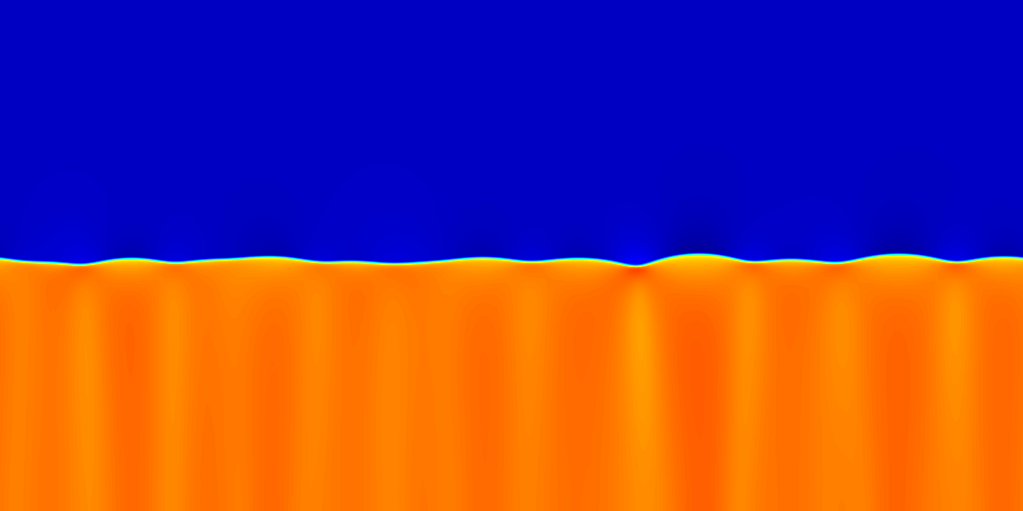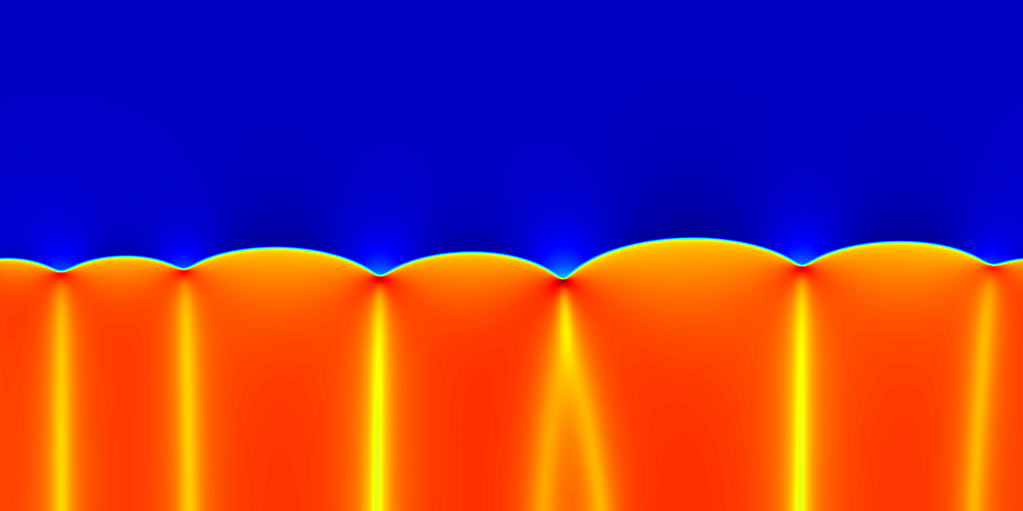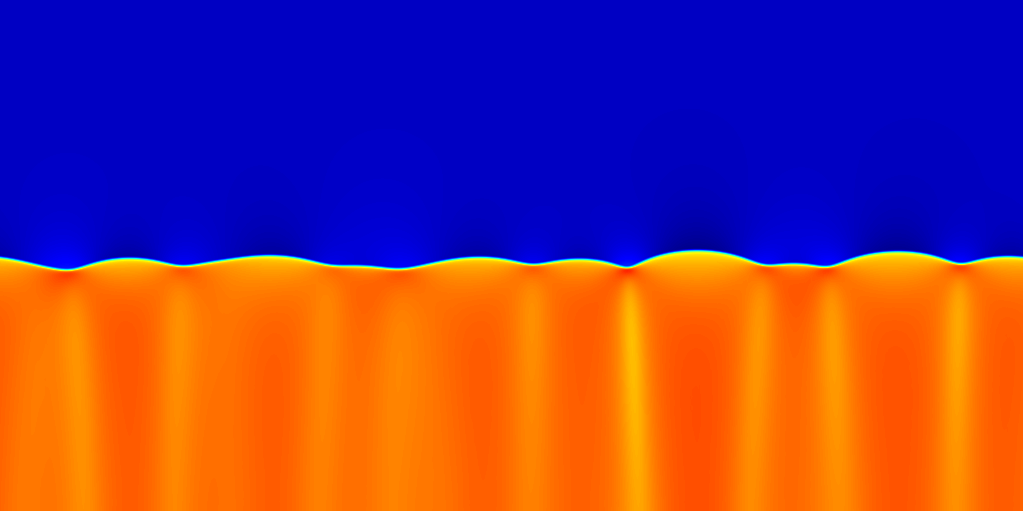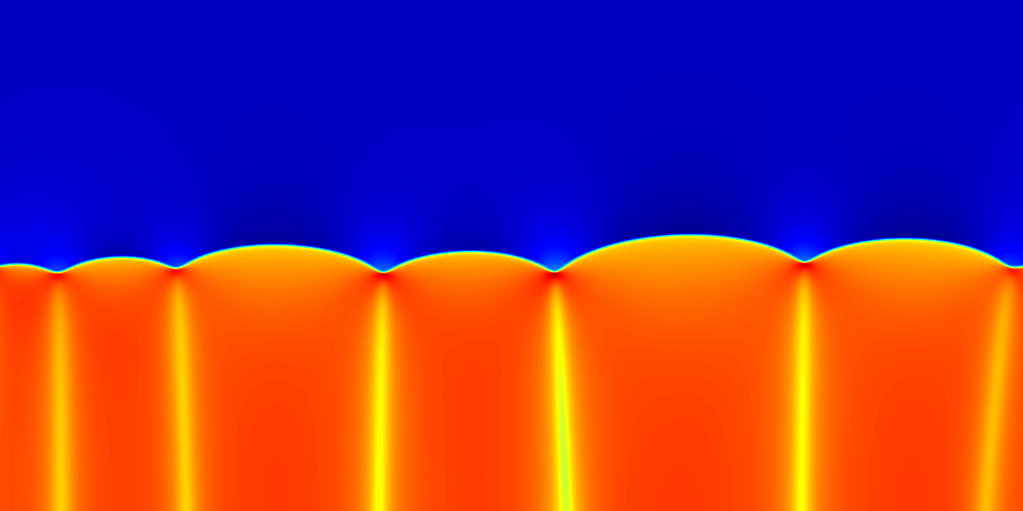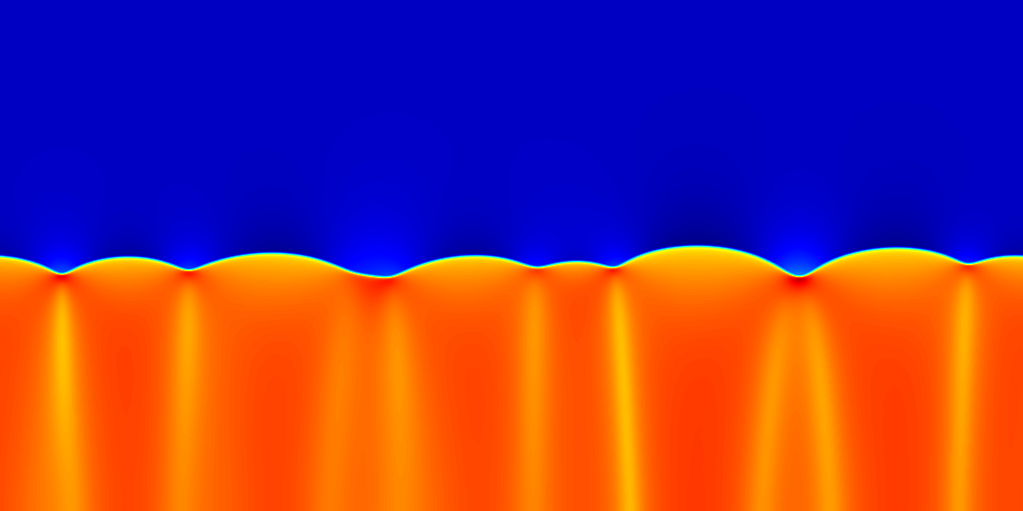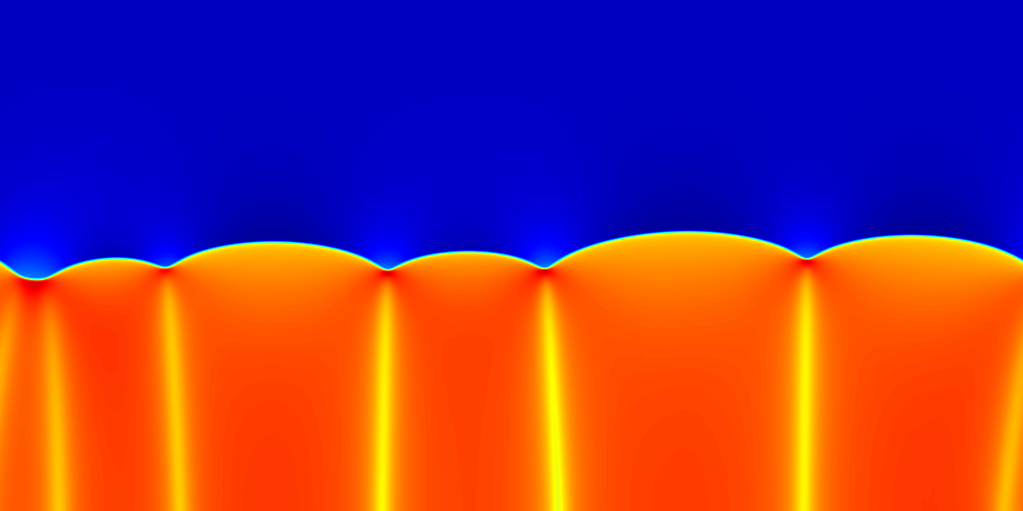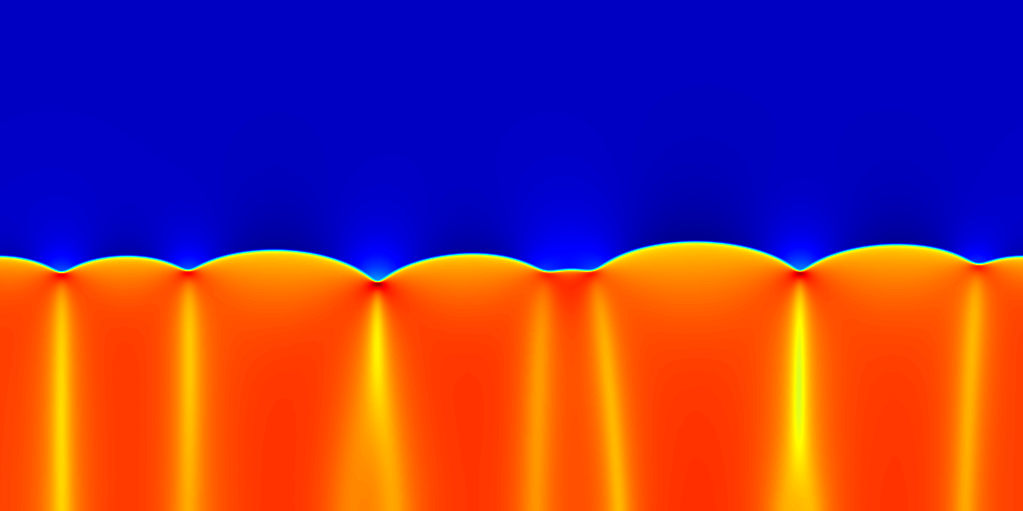
Home |
Research |
Publications |
People |
Software |
Links |
Downloads |
Two-Dimensional Instabilities in Thermonuclear Flames
Within the star there are numerous mechanisms that have the potential to accelerate a deflagration wave. Landau-Darrieus(LD) instabilities can lead to wrinkling of the flame. Because the lighter ash lies below the heavier carbon-oxygen fuel, the flame interface is also subject to Rayleigh-Taylor(RT) and Kelvin-Helmholtz instabilities. Finally, the flame can be accelerated by interaction with turbulence arising from convective instabilities within the flame as well as turbulence generated by the deflagration itself.
Hydrodynamic Instabilities
Landau and Lifschitz (Fluid Mechanics, 2nd Edition, § 128), describe conditions for stability of a planar flame front under taking into account the influences and gravity and capillary forces. The conditions for instability under small deviations of the planar interface are given by an dispersion relation in horizontal wave number k and decay rate Ω are given by a dispersion relation obtained implicitly by
Ω2(v1+v2) + 2Ωkv1v2 + k2(v1-v2) v1v2 - gk(v1-v2) = 0
where g is the acceleration of the interface due to gravity, v(1/2) is vertical flow speed in the (fuel/ash), and we have ignored the influence if capillary pressure.
Landau-Darrieus Instability
In the limit where the acceleration due to gravity can be ignored, the roots of Landau's dispersion relation are both real, one positive and one negative; therefore the flow at the flame sheet is unstable against small perturbations. Effects of finite flame thickness, and the variability of rate of combustion as a function flame front curvature modify the growth of the flame sheet perturbations.
The following figure shows the late form appearance of a LD cusp for the case of 12C flame at a density of 5 107 gm/cm3. The 12C fuel flows from the top of the figure, into a pre-heated 24Mg ash at the laminar flame speed. The laminar flame speed was obtained by finding a stationary solution of the 12C flame in a one-dimensional configuration. The laminar flame solution was used to initialize a two-dimensional interface between a system of cool fuel and hot ash in contact.

|
Temperature Movie: [ MPEG, MOV ]
The following time snapshots show that LD cusps coalesce with time.
Vertical Velocity Movie [ MPEG, MOV ]
Rayleigh-Taylor Instabilities
Landau's dispersion relation, in the limit of large gravity, yields the classical RT dispersion relation
Ω2 = kgΔρ/2ρavg
Which is unstable when the density of the fuel is greater that the density of the ash.
Rayleigh-Taylor (RT) instabilities arise when a less dense material supports a denser material against the action of some body force, such as gravity. The unique feature of these 2D simulations is the inclusion of the additional effect of the nuclear combustion of dense carbon into the less dense magnesium ash. In this numerical experiment, 12C fuel, in a 50% mixture with 16O as an inert dilutent, inflows from the top of the domain into contact with hot 24Mg ash. The force of gravity is directed from the top of the image to the bottom with an acceleration of 109 cm/s2, and the nuclear flame burns from the bottom to the top. The 12C inflow speed is at the laminar flame speed, Sf (2934 cm/s); the laminar flame thickness, lf is approximately 1.5 cm. The computational domain is approximately 100 lf by 200 lf.
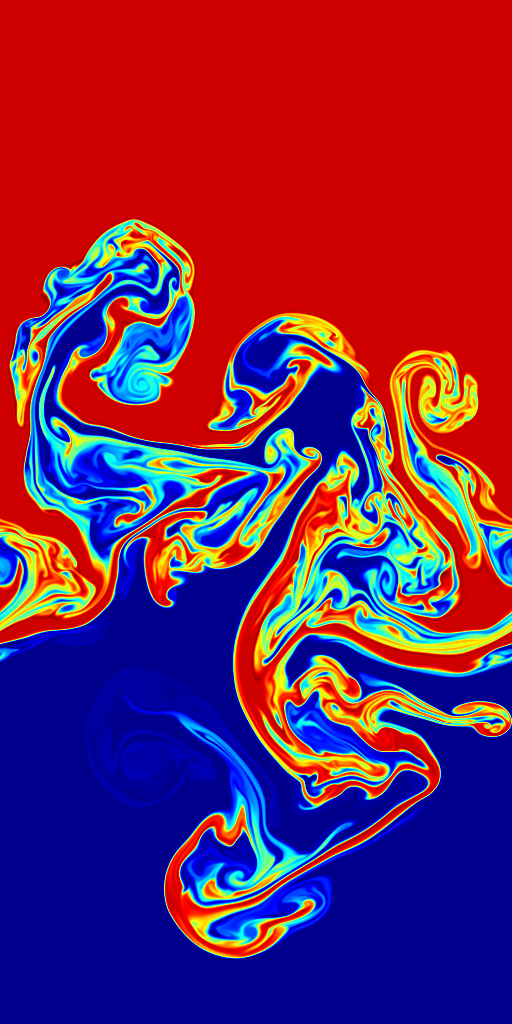
|
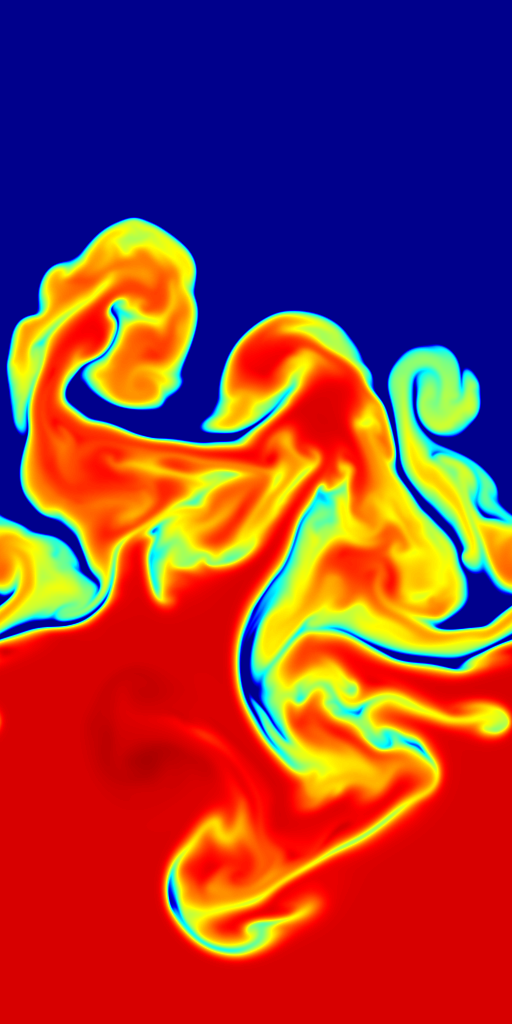
|
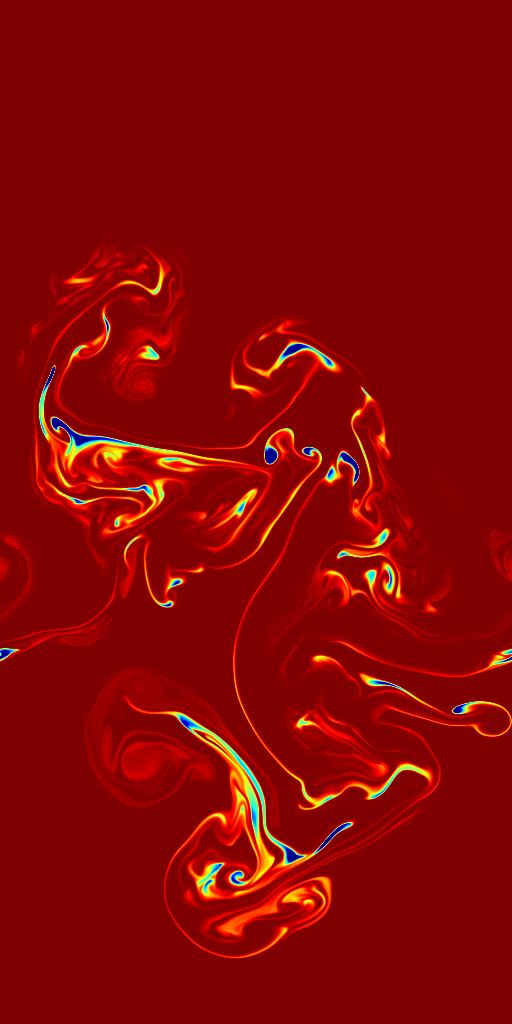
|

|
| Carbon Mass Fraction | Temperature | Reaction Rate | Vorticity |
| [ MPEG, MOV ] | [ MPEG, MOV ] | [ MPEG, MOV ] | [ MPEG, MOV ] |
Transitional LD/RT Regime
In the region in which the gravitational contribution to the Landau dispersion relation are of the same order as the other terms when the wavelength of the perturbations, λ
λ = 1/(gρ1ρ2),
In the following simulation the 12C fuel in 50% mixture with dilutent 16O with density 1.5 107 g/cm3 flows in from the top of the domain at the laminar flame speed. Note that in these simulations that characteristic Rayleigh-Taylor mushrooms are are burned away before a significantly turbulent appearance results. These qualitatively different that those of the previous case.
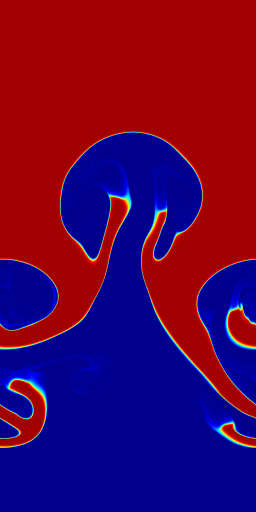
|
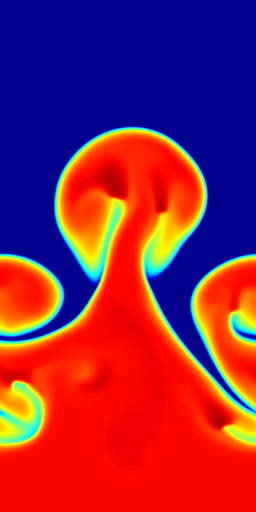
|
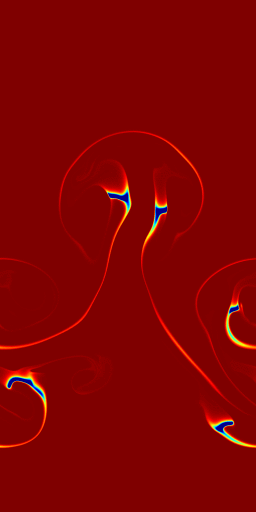
|

|
| Carbon Mass Fraction | Temperature | Reaction Rate | Vorticity |
| [ MPEG, MOV ] | [ MPEG, MOV ] | [ MPEG, MOV ] | [ MPEG, MOV ] |
References
J. B. Bell, M. S. Day, C. A. Rendleman, S. E. Woosley, and M. A. Zingale, "Adaptive low Mach number simulations of nuclear flame microphysics", LBNL Report 52395, J. Comp. Phys, 195, 677-694, 2004. [pdf]
J. B. Bell, M. S. Day, C. A. Rendleman, S. E. Woosley, and M. A. Zingale, "Direct Numerical Simulations of Type Ia Supernovae Flames I: The Landau-Darrieus Instability", LBNL Report LBNL-54088, Astrophysical Journal, 606, 1029-1038, 2004. [pdf]
J. B. Bell, M. S. Day, C. A. Rendleman, S. E. Woosley, and M. A. Zingale, ``Direct Numerical Simulations of Type Ia Supernovae Flames II: The Rayleigh-Taylor Instability,'', LBNL Report 54300, Astrophysical Journal, 608, 883-906, 2004. [pdf]
M. Zingale, S. E. Woosley, C.A. Rendleman, M. S. Day, and J. B. Bell, ``Three-dimensional Numerical Simulations of Rayleigh-Taylor Unstable Flames in Type Ia Supernovae'', LBNL Report LBNL-56966, submitted, Astrophysical Journal, 2005. [pdf]
